2009 HONDA FIT airbag off
[x] Cancel search: airbag offPage 7 of 352

ꭧ1: To use the horn, press the center pad of the steering wheel.
ꭧ 2: If equipped.
ꭧ 3: Only on vehicles equipped with navigation system. Refer to the navigation system manual.Vehicle with navigation system is shown. PADDLE SHIFTER
(DOWNSHIFT)
ꭧ 2
(P. 224 )
HEADLIGHTS/
TURN SIGNAL/
FOG LIGHTS
ꭧ 2
(P. 74)
REMOTE AUDIO
CONTROL
BUTTONS
ꭧ 2
(P. 189)
NAVIGATION
SYSTEM VOICE
CONTROL
BUTTONS
ꭧ 3
VEHICLE STABILITY
ASSIST (VSA)
SYSTEM OFF
SWITCH
ꭧ2
(P. 234 )
STEERING WHEEL ADJUSTMENTS
(P.77) CRUISE CONTROL BUTTONS
ꭧ
2
(P. 194)
HORN
ꭧ
1
PADDLE SHIFTER
(UPSHIFT)
ꭧ2
(P. 224)
INSTRUMENT PANEL
BRIGHTNESS (P.
76)
HAZARD WARNING
BUTTON
(P.76)
WINDSHIELD WIPERS/WASHERS
(P.73)
PASSENGER
AIRBAG OFF
INDICATOR
(P.31)
REAR WINDOW
DEFOGGER/
HEATED MIRROR
BUTTON
ꭧ 2
(P. 76/102)
AUXILIARY INPUT JACK
(P. 190)
ACCESSORY POWER SOCKET
(P. 106)
Your Vehicle at a Glance4
2009 Fit
Page 8 of 352
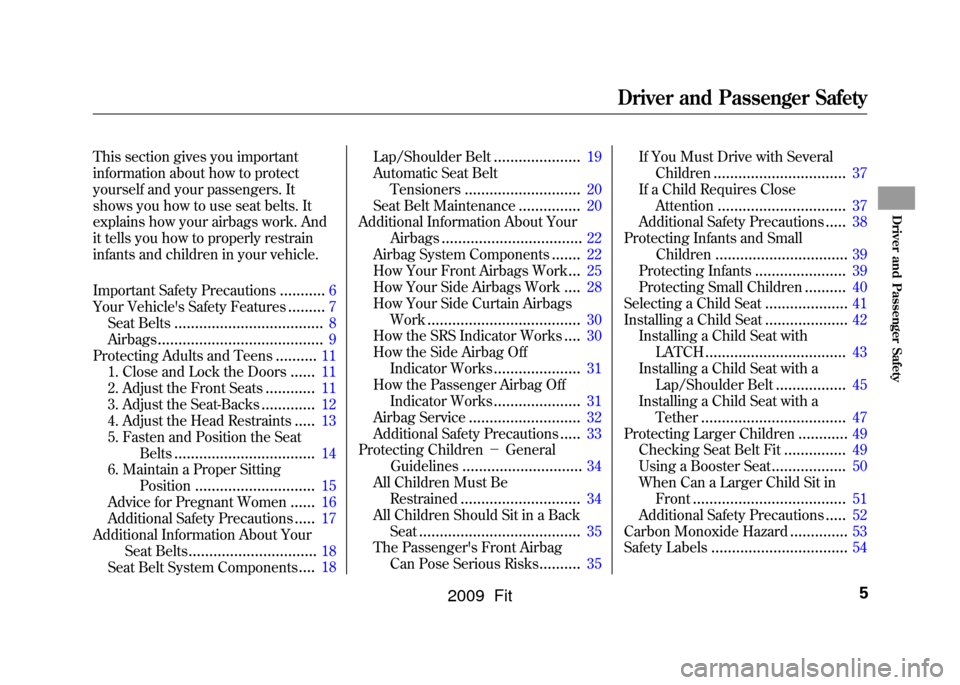
This section gives you important
information about how to protect
yourself and your passengers. It
shows you how to use seat belts. It
explains how your airbags work. And
it tells you how to properly restrain
infants and children in your vehicle.
Important Safety Precautions
...........
6
Your Vehicle's Safety Features
.........
7
Seat Belts
....................................
8
Airbags
........................................
9
Protecting Adults and Teens
..........
11
1. Close and Lock the Doors
......
11
2. Adjust the Front Seats
............
11
3. Adjust the Seat-Backs
.............
12
4. Adjust the Head Restraints
.....
13
5. Fasten and Position the Seat
Belts
..................................
14
6. Maintain a Proper Sitting
Position
.............................
15
Advice for Pregnant Women
......
16
Additional Safety Precautions
.....
17
Additional Information About Your Seat Belts
...............................
18
Seat Belt System Components
....
18 Lap/Shoulder Belt
.....................
19
Automatic Seat Belt
Tensioners
............................
20
Seat Belt Maintenance
...............
20
Additional Information About Your Airbags
..................................
22
Airbag System Components
.......
22
How Your Front Airbags Work
...
25
How Your Side Airbags Work
....
28
How Your Side Curtain Airbags Work
.....................................
30
How the SRS Indicator Works
....
30
How the Side Airbag Off
Indicator Works
.....................
31
How the Passenger Airbag Off Indicator Works
.....................
31
Airbag Service
...........................
32
Additional Safety Precautions
.....
33
Protecting Children -General
Guidelines
.............................
34
All Children Must Be Restrained
.............................
34
All Children Should Sit in a Back Seat
.......................................
35
The Passenger's Front Airbag
Can Pose Serious Risks
..........
35 If You Must Drive with Several
Children
................................
37
If a Child Requires Close Attention
...............................
37
Additional Safety Precautions
.....
38
Protecting Infants and Small Children
................................
39
Protecting Infants
......................
39
Protecting Small Children
..........
40
Selecting a Child Seat
....................
41
Installing a Child Seat
....................
42
Installing a Child Seat with LATCH
..................................
43
Installing a Child Seat with a Lap/Shoulder Belt
.................
45
Installing a Child Seat with a Tether
...................................
47
Protecting Larger Children
............
49
Checking Seat Belt Fit
...............
49
Using a Booster Seat
..................
50
When Can a Larger Child Sit in Front
.....................................
51
Additional Safety Precautions
.....
52
Carbon Monoxide Hazard
..............
53
Safety Labels
.................................
54
Driver and Passenger Safety
5
Driver and Passenger Safety
2009 Fit
Page 13 of 352

The most important things you need
to know about your airbags are:●Airbags do not replace seat belts.They are designed to supplement
the seat belts.●Airbags offer no protection in rearimpacts, or minor frontal or side
collisions.●Airbags can pose serious hazards.To do their job, airbags must
inflate with tremendous force. So
while airbags help save lives, they
can cause minor injuries or more
serious or even fatal injuries if
occupants are not properly
restrained or sitting properly.
What you should do:
Always wear
your seat belt properly, and sit
upright and as far back from the
steering wheel as possible while
allowing full control of the vehicle. A
front passenger should move their
seat as far back from the dashboard
as possible. The rest of this section gives more
detailed information about how you
can maximize your safety.
Remember, however, that no safety
system can prevent all injuries or
deaths that can occur in a severe
crash, even when seat belts are
properly worn and the airbags
deploy.
Your Vehicle's Safety Features10
2009 Fit
Page 25 of 352
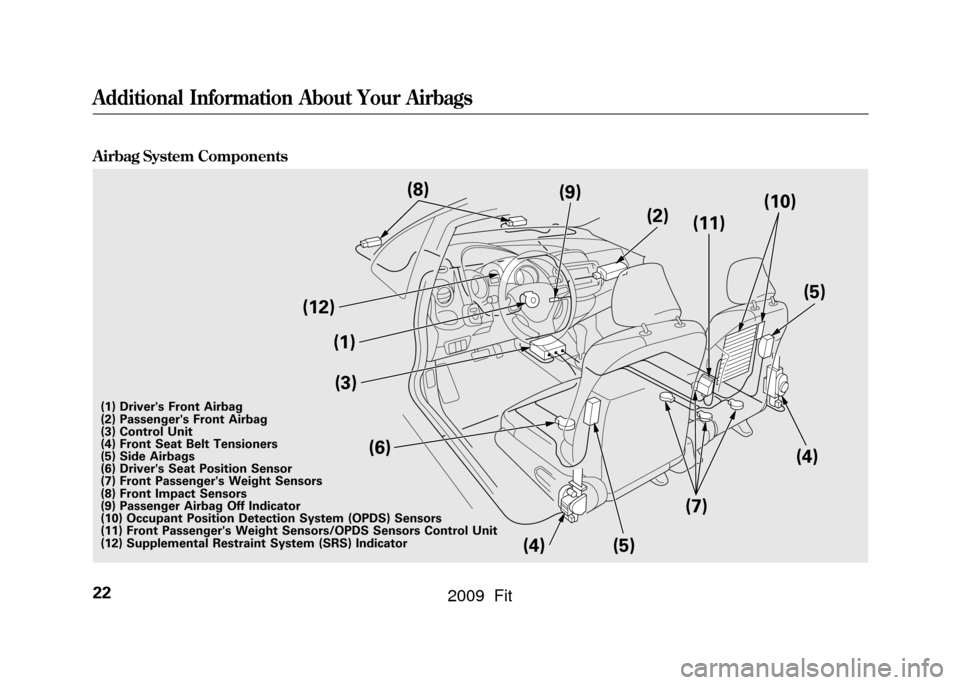
Airbag System Components
(1)(3)
(6)
(12)
(4) (5)(11)
(4)
(7) (5)
(9)
(10)
(2)
(8)
(1) Driver's Front Airbag
(2) Passenger's Front Airbag
(3) Control Unit
(4) Front Seat Belt Tensioners
(5) Side Airbags
(6) Driver's Seat Position Sensor
(7) Front Passenger's Weight Sensors
(8) Front Impact Sensors
(9) Passenger Airbag Off Indicator
(10) Occupant Position Detection System (OPDS) Sensors
(11) Front Passenger's Weight Sensors/OPDS Sensors Control Unit
(12) Supplemental Restraint System (SRS) IndicatorAdditional Information About Your Airbags22
2009 Fit
Page 27 of 352

●Automatic front seat belt
tensioners (see page20).●Sensors that can detect a moderate
to severe front impact or side
impact.●Sensors that can detect whether a
child is in the passenger's side
airbag path and signal the control
unit to turn the airbag off (see
page29).●Sensors that can detect whether
the driver's seat belt and the front
passenger's seat belt are latched or
unlatched (see page18).●A driver's seat position sensor that
monitors the distance of the seat
from the front airbag. If the seat is
too far forward, the airbag will
inflate with less force (see page
27).
●Weight sensors that monitor the
weight on the front passenger's
seat. If the weight is about 65 lbs
(29 kg) or less (the weight of an
infant or small child), the
passenger's front airbag will be
turned off (see page27).●A sophisticated electronic system
that continually monitors and
records information about the
sensors, the control unit, the
airbag activators, the seat belt
tensioners, and driver and front
passenger seat belt use when the
ignition switch is in the ON (II)
position.●An indicator on the instrument
panel that alerts you to a possible
problem with your airbags,
sensors, or seat belt tensioners
(see page30).
●An indicator on the instrument
panel that alerts you that the
passenger's side airbag has been
turned off (see page31).●An indicator on the dashboard that
alerts you that the passenger's
front airbag has been turned off
(see page31).●Emergency backup power in case
your vehicle's electrical system is
disconnected in a crash.
Additional Information About Your Airbags24
2009 Fit
Page 28 of 352
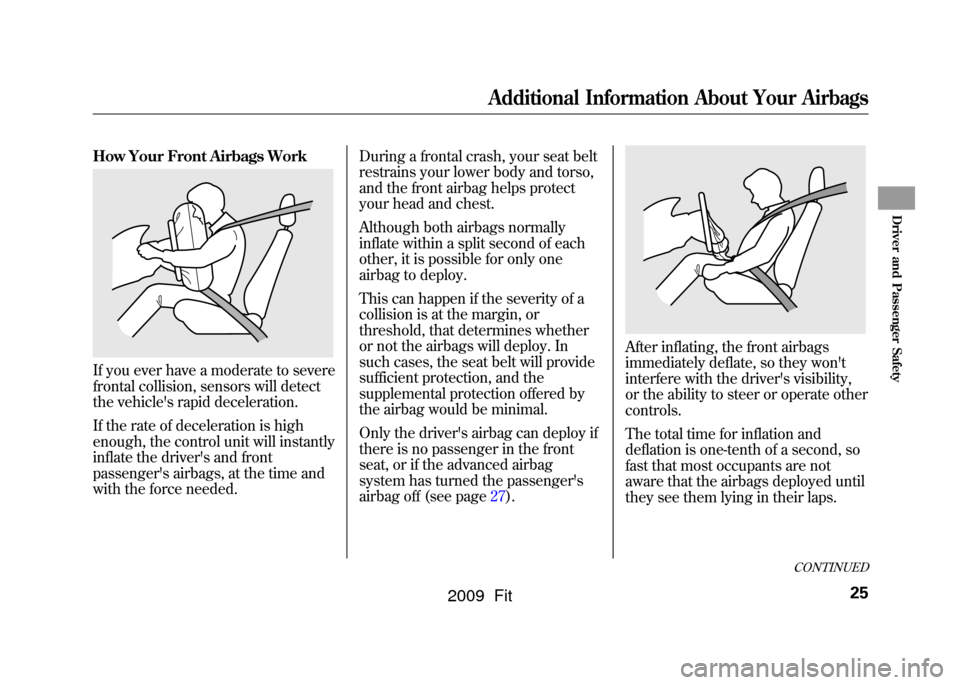
How Your Front Airbags WorkIf you ever have a moderate to severe
frontal collision, sensors will detect
the vehicle's rapid deceleration.
If the rate of deceleration is high
enough, the control unit will instantly
inflate the driver's and front
passenger's airbags, at the time and
with the force needed.During a frontal crash, your seat belt
restrains your lower body and torso,
and the front airbag helps protect
your head and chest.
Although both airbags normally
inflate within a split second of each
other, it is possible for only one
airbag to deploy.
This can happen if the severity of a
collision is at the margin, or
threshold, that determines whether
or not the airbags will deploy. In
such cases, the seat belt will provide
sufficient protection, and the
supplemental protection offered by
the airbag would be minimal.
Only the driver's airbag can deploy if
there is no passenger in the front
seat, or if the advanced airbag
system has turned the passenger's
airbag off (see page27).
After inflating, the front airbags
immediately deflate, so they won't
interfere with the driver's visibility,
or the ability to steer or operate other
controls.
The total time for inflation and
deflation is one-tenth of a second, so
fast that most occupants are not
aware that the airbags deployed until
they see them lying in their laps.
CONTINUED
Additional Information About Your Airbags
25
Driver and Passenger Safety
2009 Fit
Page 30 of 352
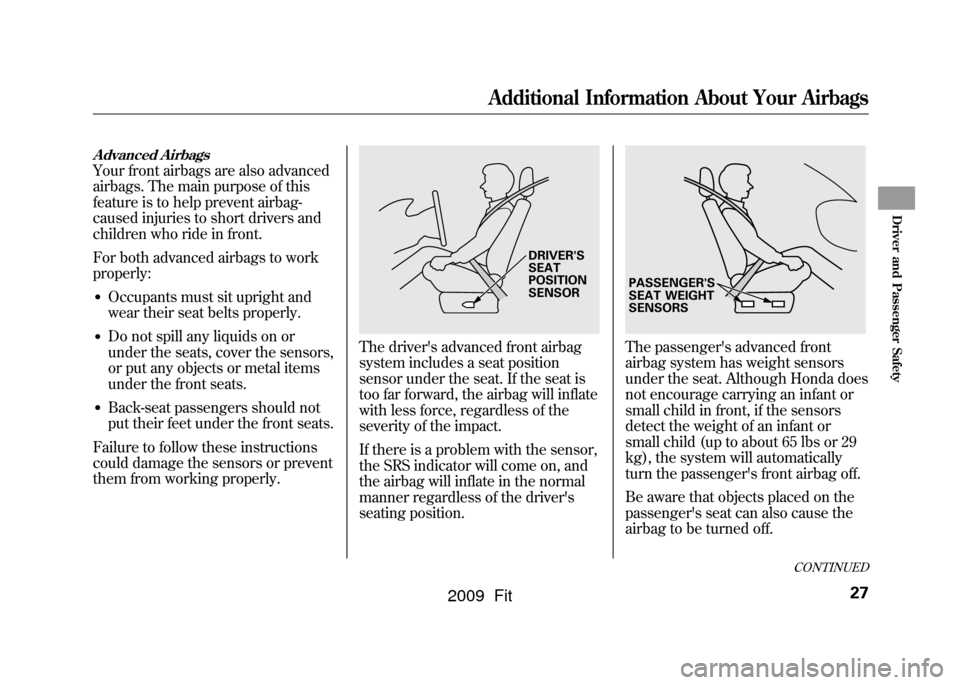
Advanced AirbagsYour front airbags are also advanced
airbags. The main purpose of this
feature is to help prevent airbag-
caused injuries to short drivers and
children who ride in front.
For both advanced airbags to work
properly:●Occupants must sit upright and
wear their seat belts properly.●Do not spill any liquids on or
under the seats, cover the sensors,
or put any objects or metal items
under the front seats.●Back-seat passengers should not
put their feet under the front seats.
Failure to follow these instructions
could damage the sensors or prevent
them from working properly.
The driver's advanced front airbag
system includes a seat position
sensor under the seat. If the seat is
too far forward, the airbag will inflate
with less force, regardless of the
severity of the impact.
If there is a problem with the sensor,
the SRS indicator will come on, and
the airbag will inflate in the normal
manner regardless of the driver's
seating position.
The passenger's advanced front
airbag system has weight sensors
under the seat. Although Honda does
not encourage carrying an infant or
small child in front, if the sensors
detect the weight of an infant or
small child (up to about 65 lbs or 29
kg), the system will automatically
turn the passenger's front airbag off.
Be aware that objects placed on the
passenger's seat can also cause the
airbag to be turned off.
DRIVER'S
SEAT
POSITION
SENSOR
PASSENGER'S
SEAT WEIGHT
SENSORS
CONTINUED
Additional Information About Your Airbags
27
Driver and Passenger Safety
2009 Fit
Page 31 of 352
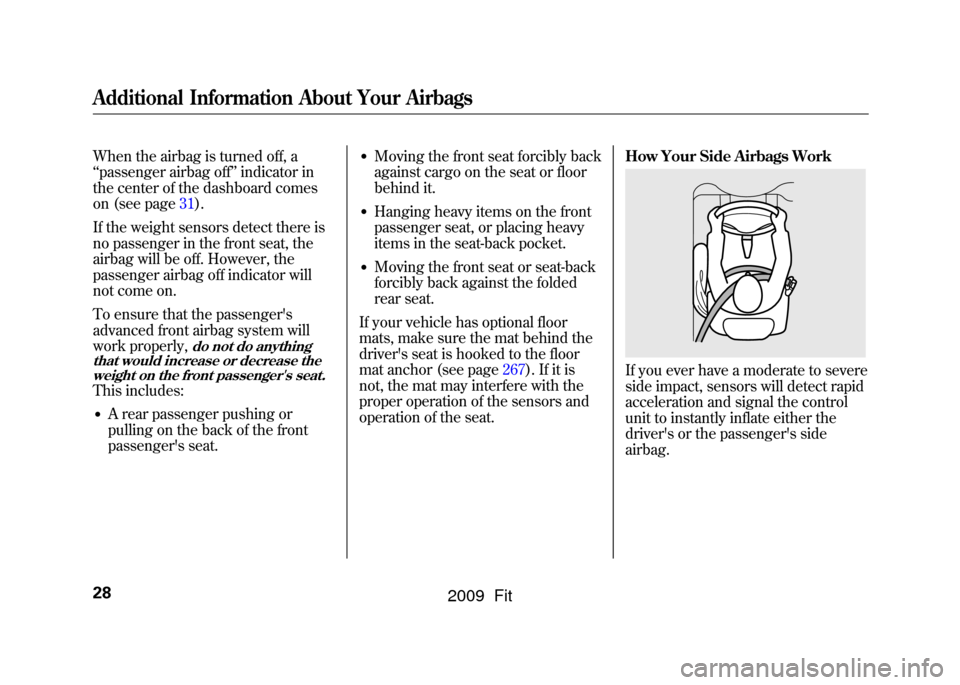
When the airbag is turned off, a
‘‘passenger airbag off ’’indicator in
the center of the dashboard comes
on (see page31).
If the weight sensors detect there is
no passenger in the front seat, the
airbag will be off. However, the
passenger airbag off indicator will
not come on.
To ensure that the passenger's
advanced front airbag system will
work properly,
do not do anything
that would increase or decrease the weight on the front passenger's seat.
This includes:●A rear passenger pushing or
pulling on the back of the front
passenger's seat.
●Moving the front seat forcibly back
against cargo on the seat or floor
behind it.●Hanging heavy items on the front
passenger seat, or placing heavy
items in the seat-back pocket.●Moving the front seat or seat-back
forcibly back against the folded
rear seat.
If your vehicle has optional floor
mats, make sure the mat behind the
driver's seat is hooked to the floor
mat anchor (see page267).If it is
not, the mat may interfere with the
proper operation of the sensors and
operation of the seat. How Your Side Airbags Work
If you ever have a moderate to severe
side impact, sensors will detect rapid
acceleration and signal the control
unit to instantly inflate either the
driver's or the passenger's side
airbag.
Additional Information About Your Airbags28
2009 Fit